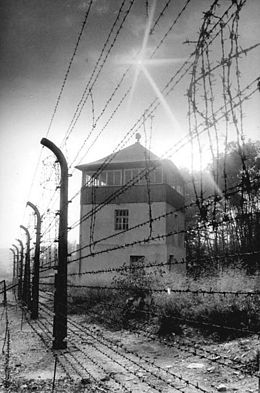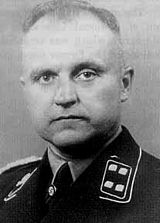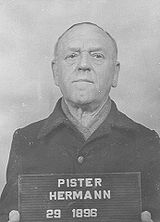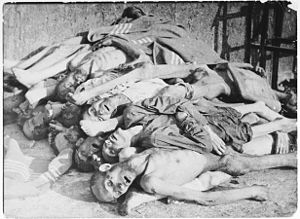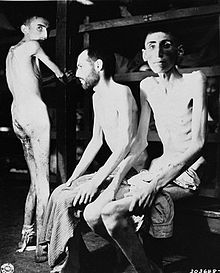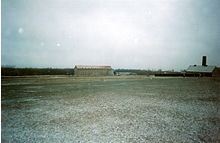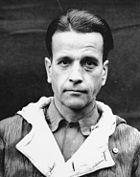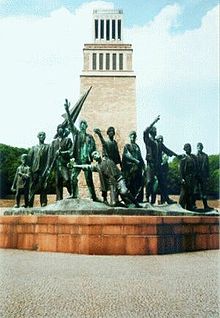- Buchenwald concentration camp
-
Coordinates: 51°01′20″N 11°14′53″E / 51.02222°N 11.24806°E
Buchenwald concentration camp (German: Konzentrationslager (KZ) Buchenwald, IPA: [ˈbuːxənvalt]) was a German Nazi concentration camp established on the Ettersberg (Etter Mountain) near Weimar, Germany, in July 1937, one of the first and the largest of the concentration camps on German soil.
Camp prisoners from all over Europe and Russia—Jews, non-Jewish Poles and Slovenes, religious and political prisoners, Roma and Sinti, Jehovah's Witnesses, criminals, homosexuals, and prisoners of war— worked primarily as forced labor in local armament factories.[1] From 1945 to 1950, the camp was used by the Soviet occupation authorities as an internment camp, known as NKVD special camp number 2.
Contents
History
 Buchenwald's main gate, with the slogan Jedem das Seine (literally, "to each his own", but figuratively "everyone gets what he deserves")
Buchenwald's main gate, with the slogan Jedem das Seine (literally, "to each his own", but figuratively "everyone gets what he deserves")
In 1937, the Nazis constructed Buchenwald concentration camp, near Weimar, Germany. Embedded in the camp's main entrance gate is the slogan Jedem das Seine (literally "to each his own", but figuratively "everyone gets what he deserves”). The camp was operational until its liberation in 1945. Between 1945 and 1950 the former camp was used by the Soviet Union as an NKVD special camp for Nazis. On 6 January 1950, the Soviets handed over Buchenwald to the East German Ministry of Internal Affairs.
Originally the camp was named after the hill Ettersberg but it was later renamed to Buchenwald (German for beech forest) because of the close ties of the location to Johann Wolfgang von Goethe, who was being idealized as “the embodiment of the German Spirit” (Verkörperung des deutschen Geistes). The Goethe Eiche (Goethe's Oak) stood inside the camp's perimeter,[2][3] and the stump of the tree is preserved as part of the memorial at KZ Buchenwald.[4]
Between April 1938 and April 1945, some 238,380 people of various nationalities including 350 Western Allied POWs were incarcerated in Buchenwald. One estimate places the number of deaths in Buchenwald at 56,000.
During an American bombing raid on August 24, 1944 that was directed at a nearby armament factory, several bombs, including incendiaries, also fell on the camp, resulting in heavy casualties amongst the prisoners[5] and damage to the Goethe Eiche.
People
Camp commandants
- SS-Sturmbannführer: Jacob Weiseborn (1937 )
- SS-Obersturmbannführer: Karl Otto Koch (1937–1942)
- SS-Standartenführer: Hermann Pister (1942–1945)
Buchenwald’s second commandant was Karl Otto Koch, who ran the camp from 1937 to 1941. His second wife, Ilse Koch, became notorious as Die Hexe von Buchenwald ("the witch of Buchenwald") for her cruelty and brutality. Koch had a zoo built by the prisoners in the camp for the amusement of his children, with a bear pit (Bärenzwinger)[6] facing the Appellplatz, the dreaded assembly square where prisoners were forced to stand motionless and silent for many hours (twice each day) while the meticulous "roll-calls" were conducted.
Koch was eventually himself imprisoned at Buchenwald by the Nazi authorities for corruption, embezzlement, black market dealings, and his exploitation of camp workers for personal gain. He was tried and executed by the Nazis at Buchenwald in April 1945, while Ilse was sentenced to four years after the war. Her sentence was reduced to two years and she was set free. Later, she was arrested again and sentenced to life imprisonment by the post-war German authorities; she committed suicide in a Bavarian prison cell in September 1967.
The third and last commandant of the camp was Hermann Pister (1942–1945). He was tried in 1947 (Dachau Trials) and sentenced to death, but died in September 1948 of a heart condition before sentence could be carried out.
Female prisoners and overseers
The number of women held in Buchenwald was somewhere between 500 and 1,000. The first female inmates were twenty political prisoners who were accompanied by a female SS guard (Aufseherin); these women were brought to Buchenwald from Ravensbrück in 1941 and forced into prostitition at the camps' brothel . Later the SS fired the SS woman on duty in the brothel for corruption, and her position was taken over by “brothel mothers” as ordered by SS chief Heinrich Himmler.
The majority of women prisoners, however, arrived in 1944 and 1945 from other camps, mainly Auschwitz, Ravensbrück, and Bergen Belsen. Only one barrack was set aside for them; this was overseen by the female block leader (Blockführerin) Franziska Hoengesberg, who came from Essen when it was evacuated. All the women prisoners were later shipped out to one of Buchenwald's many female satellite camps in Sömmerda, Buttelstedt, Mühlhausen, Gotha, Gelsenkirchen, Essen, Lippstadt, Weimar, Magdeburg, and Penig, to name a few. No female guards were permanently stationed at Buchenwald.
When the Buchenwald camp was evacuated, the SS sent the male prisoners to other camps, and the five-hundred remaining women (including one of the secret annexe members who lived with Anne Frank, "Mrs. van Daan", real name Auguste van Pels) were taken by train and on foot to the Theresienstadt concentration camp and ghetto in Protectorate of Bohemia and Moravia. Many, including van Pels, died sometime between April 1945 and May 1945. Because the female prisoner population at Buchenwald was comparatively small, the SS only trained female overseers at the camp and "assigned" them to one of the female subcamps. Twenty-two known female guards have personnel files at the camp, but it is unlikely that any of them stayed at Buchenwald for longer than a few days.
Ilse Koch served as head supervisor (Oberaufseherin) of 22 other female guards and hundreds of women prisoners in the main camp. Eventually, more than 530 women served as guards in the vast Buchenwald system of subcamps and external commands across Germany. Only 22 women served/trained in Buchenwald, compared to over 15,500 men.[7]
Allied airmen
Main article: Phil LamasonAlthough it was highly unusual for German authorities to send Western Allied prisoners of war (POWs) to concentration camps, Buchenwald held a group of 168 aviators for two months.[8] These POWs were from the United States, United Kingdom, Canada, Australia and New Zealand. They all arrived at Buchenwald on August 20, 1944.[9][10]
All these airmen were in planes which had crashed in occupied France. Two explanations are given for them being sent to a concentration camp: first, that they had managed to make contact with the French Resistance, some were disguised as civilians, and they were carrying false papers when caught; they were therefore categorized by the Germans as spies, which meant their rights under the Geneva Convention were not respected. The second explanation is that they had been categorised as Terrorflieger ("terror aviators"). The aviators were initially held in Gestapo prisons and headquarters in France. In April or August 1944, they and other Gestapo prisoners were packed into covered goods wagons (US: boxcars) and sent to Buchenwald. The journey took five days, during which they received very little food or water. One aviator recalled their arrival at Buchenwald:
“ As we got close to the camp and saw what was inside... a terrible, terrible fear and horror entered our hearts. We thought, what is this? Where are we going? Why are we here? And as you got closer to the camp and started to enter the camp and saw these human skeletons walking around—old men, young men, boys, just skin and bone, we thought, what are we getting into? ” —A Canadian airman's recollection of his arrival at Buchenwald.[11]
They were subjected to the same treatment and abuse as other Buchenwald prisoners until October 1944, when a change in policy saw the aviators dispatched to Stalag Luft III, a regular prisoner-of-war camp (POW) camp; nevertheless, two airmen died at Buchenwald.[12] Those classed as terrorflieger had been scheduled for execution after October 24; their rescue was effected by Luftwaffe officers who visited Buchenwald and, on their return to Berlin, demanded the airmen's release.[10]
Buchenwald was also the main imprisonment for a number of Norwegian university students from 1943 until the end of the war. The students, being Norwegian, got better treatment than most, but had to resist Nazi schooling for months. They became remembered for resisting forced labor in a minefield, as the Nazis wished to use them as cannon fodder. An incident connected to this is remembered as the Strike at Burkheim. The Norwegian students in Buchenwald lived in a warmer, stone-construction house and had their own clothes.[13]
Death toll at Buchenwald
Causes of death
Although Buchenwald was technically not an extermination camp, it was a site of an extraordinary number of deaths.
A primary cause of death was illness due to harsh camp conditions, with starvation—and its consequent illnesses—prevalent. Malnourished and suffering from disease, many were literally "worked to death" under the Vernichtung durch Arbeit policy (extermination through labor), as inmates had only the choice between slave labour or inevitable execution. Many inmates died as a result of human experimentation or fell victim to arbitrary acts perpetrated by the SS guards. Other prisoners were simply murdered, primarily by shooting and hanging.
Walter Gerhard Martin Sommer was an SS Hauptscharführer (master sergeant) who served as a guard at the concentration camps of Dachau and Buchenwald. Known as the "Hangman of Buchenwald", he was considered a depraved sadist who reportedly ordered Otto Neururer and Mathias Spannlang, two Austrian priests, crucified upside-down. Sommer was especially infamous for hanging prisoners from trees with their wrists behind their backs in the "singing forest", so named because of the screams which emanated from this wooded area.[14][15]
Summary executions of Soviet POWs were also carried out at Buchenwald. At least 1,000 Soviet POWs were selected in 1941–2 by a task force of three Dresden Gestapo officers and sent to the camp for immediate liquidation by a gunshot to the back of the neck, the infamous Genickschuss.
The camp was also a site of large-scale trials for vaccines against epidemic typhus in 1942 and 1943. In all 729 inmates were used as test subjects, of whom 154 died.[16] Other "experimentation" occurred at Buchenwald on a smaller scale. One such experiment aimed at determining the precise fatal dose of a poison of the alkaloid group; according to the testimony of one doctor, four Russian POWs were administered the poison, and when it proved not to be fatal they were "strangled in the crematorium" and subsequently "dissected".[17] Among various other experiments was one which, in order to test the effectiveness of a balm for wounds from incendiary bombs, involved inflicting "very severe" phosphorus burns on inmates.[18] When challenged at trial over the nature of this testing, and particularly over the fact that the testing was designed in some cases to cause death and only to measure the time which elapsed until death was caused, one Nazi doctor's defence was that, though a doctor, he was "legally appointed executioner".[19]
Number of deaths
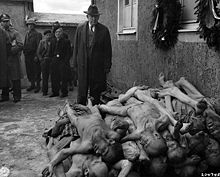 US Senator Alben W. Barkley (D-KY) looks on after Buchenwald's liberation. Barkley later became Vice President of the United States under Harry S. Truman.
US Senator Alben W. Barkley (D-KY) looks on after Buchenwald's liberation. Barkley later became Vice President of the United States under Harry S. Truman.
The SS left behind accounts of the number of prisoners and people coming to and leaving the camp, categorizing those leaving them by release, transfer, or death. These accounts are one of the sources of estimates for the number of deaths in Buchenwald. According to SS documents, 33,462 died in Buchenwald. These documents were not, however, necessarily accurate: Among those executed before 1944 many were listed as "transferred to the Gestapo". Furthermore, from 1941 forward Soviet POWs were executed in mass killings. Arriving prisoners selected for execution were not entered into the camp register and therefore were not among the 33,462 dead listed in SS documents.[20]
One former Buchenwald prisoner, Armin Walter, calculated the number of executions by shooting in the back of the head. His job at Buchenwald was to set up and care for a radio installation at the facility where people were executed and counted the numbers, which arrived by telex, and hid the information. He says that 8,483 Soviet prisoners of war were shot in this manner.[21]
According to the same source, the total number of deaths at Buchenwald is estimated at 56,545.[22] This number is the sum of:
- Deaths according to material left behind by SS: 33,462[23]
- Executions by shooting: 8,483
- Executions by hanging (estimate): 1,100
- Deaths during evacuation transports: 13,500[24]
This total (56,545) corresponds to a death rate of 24 percent assuming that the number of persons passing through the camp according to documents left by the SS, 238,380 prisoners, is accurate.[25]
Liberation from Nazi Germany
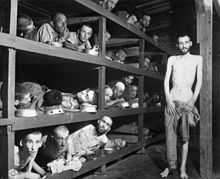 Buchenwald survivors following their liberation. Elie Wiesel is on the second row from the bottom, seventh from the left.
Buchenwald survivors following their liberation. Elie Wiesel is on the second row from the bottom, seventh from the left.
On April 4, 1945, the U.S. 89th Infantry Division overran Ohrdruf, a subcamp of the Buchenwald. It was the first Nazi camp liberated by U.S. troops.[26]
Buchenwald was partially evacuated by the Germans on April 8, 1945. In the days before the arrival of the American army, thousands of the prisoners were forced to join the evacuation marches.[citation needed]
Thanks to the efforts of Polish engineer Gwidon Damazyn, an inmate since March 1941, a secret radio transmitter and small generator were built. On April 9 at 1pm Damazyn sent the radio message prepared by leaders of prisoners' underground (Walter Bartel and Harry Kuhn):
“ To Allies. To General Patton's Army. This is concentration camp Buchenwald. SOS. We need help. They're trying to evacuate us. The SS try to exterminate us. ” The text was repeated four times, each time in English, German and Russian.[27] After 15 minutes the headquarters of the US Third Army answered and promised help as quickly as they could send it.
After this news had been received, Communist inmates stormed the watchtowers and killed the remaining guards using arms they had been collecting since 1942 (one machine gun and 91 rifles).[28] (See Buchenwald Resistance)
A detachment of troops belonging to the US 9th Armored Infantry Battalion, U.S. 6th Armored Division, US Third Army arrived at Buchenwald on April 11, 1945 under the leadership of Captain Frederic Keffer. The soldiers were given a hero's welcome, with the emaciated survivors finding the strength to toss some liberators into the air in celebration.[29]
Later in the day, elements of the U.S. 83rd Infantry Division overran Langenstein, one of a number of smaller camps comprising the Buchenwald complex. There the division liberated over 21,000 prisoners,[29] ordered the mayor of Langenstein to send food and water to the camp, and sped medical supplies forward from the 20th Field Hospital.[30]
Third Army Headquarters sent elements of the U.S. 80th Infantry Division to take control of the camp on the morning of Thursday, April 12, 1945. Several journalists arrived on the same day, perhaps with the 80th, including Edward R. Murrow, whose radio report of his arrival and reception was broadcast on CBS and became one of his most famous:
“ I asked to see one of the barracks. It happened to be occupied by Czechoslovaks. When I entered, men crowded around, tried to lift me to their shoulders. They were too weak. Many of them could not get out of bed. I was told that this building had once stabled 80 horses. There were 1,200 men in it, five to a bunk. The stink was beyond all description. They called the doctor. We inspected his records. There were only names in the little black book, nothing more. Nothing about who these men were, what they had done, or hoped. Behind the names of those who had died, there was a cross. I counted them. They totalled 242. 242 out of 1,200, in one month.
As we walked out into the courtyard, a man fell dead. Two others, they must have been over 60, were crawling toward the latrine. I saw it, but will not describe it.
” —Extract from Edward R. Murrow's Buchenwald report. April 15, 1945.
Soviet Special Camp 2
After liberation, between 1945 and 10 February 1950, the camp was administered by the Soviet Union and served as a Special Camp No. 2 of the NKVD.[31] It was part of a "special camps" network operating since 1945, formally integrated into the Gulag in 1948.[32][33] Another infamous "special camp" in Soviet occupied Germany was the former Nazi concentration camp Sachsenhausen (special camp No. 7).[34]
Between August 1945 and the dissolution on 1 March 1950, 28,455[35] prisoners, including 1,000 women, were held by the Soviet Union at Buchenwald. A total of 7,113 people died in Special Camp Number 2, according to the Soviet records.[35] They were buried in mass graves in the woods surrounding the camp. Their relatives did not receive any notification of their deaths. Prisoners comprised alleged opponents of Stalinism, and alleged members of the Nazi party or Nazi organization, others were imprisoned due to identity confusion and arbitrary arrests.[36][37] The NKVD would not allow any contacts of prisoners to the outside world[38] and did not attempt to determine the guilt of any individual prisoner.[37]
On 6 January 1950, Soviet Minister of Internal Affairs Kruglov ordered all special camps, including Buchenwald, to be handed over to the East German Ministry of Internal Affairs.[33]
Demolition of the camp
In October 1950, it was decreed that the camp would be demolished. The main gate, the crematorium, the hospital block, and two guard towers escaped demolition. All prisoner barracks and other buildings were razed. Foundations of some still exist and many others have been rebuilt. According to the Buchenwald Memorial website, "the combination of obliteration and preservation was dictated by a specific concept for interpreting the history of Buchenwald Concentration Camp."
The first monument to victims was erected days after the initial liberation. Intended to be completely temporary, it was built by prisoners and was made of wood. A second monument to commemorate the dead was erected in 1958 by the GDR near the mass graves. Inside the camp, there is a living monument in the place of the first monument that is kept at skin temperature year round.[39]
Notorious Nazi personnel
- Commandants
- Karl Otto Koch from 1937 to 1941
- Hermann Pister from 1942 to 1945
- Medical doctors
- Gerhard Rose
- Waldemar Hoven
- Hans Conrad Julius Reiter
- Guards
- Martin Sommer
- Nazi head of personnel
- Hermann Hackmann
Well-known inmates
- Karl Mayr, Adolf Hitler's immediate superior in an Army Intelligence Division in the Reichswehr, 1919–1920; later becoming a political opponent.
- Roy Allen, American B-17 Flying Fortress pilot
- Phillip (Phil) J. Lamason, Squadron Leader, Royal New Zealand Air Force
- Jean Améry, writer
- Jack van der Geest, escapee
- Robert Antelme, French writer
- Jacob Avigdor, before World War II Chief Rabbi of Drohobych, after World War II Chief Rabbi of Mexico
- Conrad Baars, psychiatrist
- Bruno Bettelheim, child psychologist
- Józef Biniszkiewicz, Polish socialist politician
- Léon Blum, Jewish French politician, pre-war long term French Prime Minister, and again after the war
- Dietrich Bonhoeffer, Protestant theologian and prominent member of the Confessing Church
- Rudolf Brazda, as of 2011 the last known surviving homosexual deported to the camps
- Rudolf Breitscheid, former member of the SPD and leader of its faction in the Reichstag of the Weimar Republic before the Nazi seizure of power in 1933, died in the camp in 1944
- Christopher Burney, British officer and Special Operations Executive operative, wrote about the savage infighting and struggle for power and privileges between the inmates at Buchenwald in The Dungeon Democracy
- Robert Clary, French actor, Corporal Louis LeBeau on the Hogan's Heroes television series
- René Cogny, French general
- Fritz Czuczka, Austrian artist/architect
- Seweryn Franciszek Czetwertyński-Światopełk, Polish politician
- Édouard Daladier, French politician, former Head of the French government
- Armand de Dampierre, French aristocrat, died in the camp on January 8, 1944
- Marcel Dassault, French aviation entrepreneur who founded the Dassault Group
- Laure Diebold, French resistant, Compagnon de la Libération
- Willem Drees, Dutch politician, Prime Minister of the Netherlands from 1948 until 1958
- Ernst Federn, Austrian social-psychologist
- Bolesław Fichna, Polish right-wing politician and lawyer
- Josef Frank (politician), Czech communist
- August Froehlich, German Roman Catholic priest active in resistance movement against the National Socialism
- Henry P. Glass, Austrian Architect and Industrial Designer, released in 1939, moved to U.S.
- Albin Grau, film producer (Nosferatu, 1922)
- Maurice Halbwachs French sociologist, died in the camp in 1945
- Adolf Grunbaum, Austrian physician, released from camp 1939 and emigrated to US. Changed name to Arthur Grant.
- Curt Herzstark inventor of the Curta calculator, hand-held, hand-cranked mechanical calculator
- Heinrich Eduard Jacob, German writer
- Paul-Emile Janson, Belgian politician, former Prime Minister of Belgium, died in the camp in 1944
- Marian Filar Polish Jewish concert pianist and virtuoso. Played at Carnegie Hall After the war.
- Léon Jouhaux, French trade unionist and Nobel Peace Prize laureate
- Józef Kachel, Scout leader, head of the pre-war Polish Scouting Association in Germany
- Imre Kertész writer, 2002 Nobel Prize in Literature recipient
- Eugen Kogon, anti-Nazi activist, later Christian Socialist, professor, broadcaster and author of Der SS-Staat ("The SS state"), a significant piece of literature concerning the German concentration camps
- Jan Łangowski, Polish social worker and politician active among the Polish diaspora in Germany
- Yisrael Meir Lau (born 1937), Ashkenazi Chief Rabbi of Israel
- Parlindoengan Loebis, Indonesian physician and activist in the Netherlands
- Artur London, senior Czech communist and writer, future government minister
- Jacques Lusseyran, blind French memoirist and professor
- Georges Mandel French politician, former Minister of the Interior, died in the camp in 1944
- Henri Maspero, French Sinologist, pioneering scholar of Taoism, died in the camp in March 1945
- Erik L. Mollo-Christensen, Emeritus Professor of Oceanography, MIT; former Associate Director of Earth Science, NASAtance
- Andree Peel, Member of the French resistance
- Harry Peulevé, an agent of the British Special Operations Executive (SOE) who managed to escape Buchenwald with F. F. E. Yeo-Thomas.
- Henri Christiaan Pieck, Dutch painter and twin brother of Anton Pieck
- Hélie de Saint Marc, member of the French resistance, later involved in the attempted Algiers putsch
- H.R.H. The Princess Mafalda of Savoy, the daughter of King Vittorio Emanuele III of Italy and his Consort, Queen Elena, died in the camp in 1944.
- Franciszek Myśliwiec, Polish politician and social worker
- John H. Noble, American-born gulag survivor and author
- Count Albert de Nadaillac, head of a French resistance organisation (ORA-Tours Angers Le Mans). He survived, but his younger brother, count Michel de Nadaillac, also involved in the resistance died in Dora.
- Almeric Lombard de Buffiers de Rambuteau, French aristocrat, died in the camp on December 14, 1944
- Paul Rassinier, considered the father of Holocaust denial
- Jakob Rosenfeld, minister of health under Mao
- Baron Otto of Schmidburg, minor German noble, died in the camp on July 23, 1941
- Etta Sapon, Italian, Dramatic actress
- Paul Schneider, German pastor, died in the camp in 1939
- Jorge Semprún, Spanish intellectual and politician and culture minister of Spain (1988–91)
- Jura Soyfer, Austrian poet and dramatist, died in the camp in 1939
- Ernst Thälmann, leader of the Communist Party of Germany, died in the camp in April 1944
- Fred Wander, Austrian writer
- Ernst Wiechert, German writer
- Elie Wiesel, Romanian Jewish French-American writer, 1986 Nobel Peace Prize recipient
- F. F. E. Yeo-Thomas, Royal Air Force Wing Commander and British Special Operations Executive (SOE) agent, codenamed "The White Rabbit". Returned to England in 1945
- Petr Zenkl, Czech national socialist politician
- Walter Gutheim, German business man who migrated to America after the war.
Photo gallery
See also
- The Boys of Buchenwald
- Final Solution
- The Holocaust
- John H. Noble
- Jonas Valley
- List of Nazi-German concentration camps
- List of subcamps of Buchenwald
- Nazi crimes against ethnic Poles
- Nazi-German concentration camps
- Number of deaths in Buchenwald
- Ohrdruf forced labor camp
- Buchenwald Resistance
- KLB Club
- Edward A. Tenenbaum, one of the first two people to enter Buchenwald on April 11, 1945
Notes
- ^ The History of Buchenwald Memorial.
- ^ Farmer, Sarah (Winter, 1995). "Symbols that Face Two Ways: Commemorating the Victims of Nazism and Stalinism at Buchenwald and Sachsenhausen". Representations 0 (49): 100–1. ISSN 0734-6018. JSTOR 2928751
- ^ As Vladimir Nabokov in Pnin (New York: Alfred A. Knopf, 2004) puts it, "in the beautifully wooded Grosser Ettersburg, as the region is resoundingly called. It is an hour's stroll from Weimar, where walked Goethe, Herder, Friedrich Schiller, Christoph Martin Wieland, the inimitable Kotzebue and others. 'Aber warum – but why –' Dr. Hagen, the gentlest of souls alive, would wail, 'why had one to put that horrid camp so near!' for indeed, it was near – only five miles from the cultural heart of Germany – 'that nation of universities' [...]" (p. 100).
- ^ "Goethe Eiche Buchenwald (Remainings)". Flikr. http://www.flickr.com/photos/jabb/403670900/.
- ^ The Buchenwald Report by David A Hackett Language: English ISBN 0813333636 ISBN 978-0813333632
- ^ "Bärenzwinger. Zoo Buchenwald.". 1939. http://www.buchenwald.de/fotoarchive/buchenwald/print.php?inventarnr=3796. Retrieved 28 April 2009.
- ^ Buchenwald concentration camp 1937–1945: a guide to the permanent historical. Edited by Gedenkstatte Buchenwald.Publisher: Wallstein (2005) ISBN 3892446954 ISBN 978-3892446958
- ^ Veterans Affairs Canada, 2006: "Prisoners of War in the Second World War" Accessed 16 May 2007.
- ^ National Museum of the USAF: "Allied Victims of the Holocaust" Accessed 16 May 2007.
- ^ a b Eyewitness accounts of Art Kinnis, president of KLB (Konzentrationslager Buchenwald), and 2nd Lt. Joseph Moser, one of the surviving pilots, at http://buchenwaldflyboy.wordpress.com.
- ^ From The Lucky Ones: Allied Airmen and Buchenwald (1994 film, directed by Michael Allder), cited by Veterans Affairs Canada, 2006: "Prisoners of War in the Second World War" Accessed 16 May 2007.
- ^ National Museum of the USAF, Ibid.
- ^ Redlich, Carl Aage: 19. September, 1945. p. 55.
- ^ The resistance in Austria, 1938–1945 By Radomír Luža Publisher: University of Minnesota Press (April 9, 1984) ISBN 0816612269
- ^ Harry Stein, Gedenkstätte Buchenwald: Buchenwald concentration camp 1937–1945: A Guide to the Permanent Historical Exhibition p. 302, Wallstein (2005) ISBN 3892446954
- ^ Spitz, Vivien. Doctors from Hell. 2005, page 199
- ^ Spitz, Vivien. Doctors from Hell. 2005, page 209-10
- ^ Spitz, Vivien. Doctors from Hell. 2005, page 213-14
- ^ Spitz, Vivien. Doctors from Hell. 2005, page 209
- ^ Bartel, Walter: Buchenwald—Mahnung und Verpflichtung: Dokumente und Berichte (Buchenwald: Warnings and our obligation [to future generations]—Documents and reports), Kongress-Verlag, 1960. p. 64, lines 12–23. (German).
- ^ Bartel, Walter: Buchenwald—Mahnung und Verpflichtung: Dokumente und Berichte (Buchenwald: Warnings and our obligation to future generation—Documents and reports), Kongress-Verlag, 1960. p. 203, lines 18–38. (German)
- ^ Podcast with one of 2000 Danish policemen in Buchenwald. Episode 6 is about statistics for the number of deaths at Buchenwald.
- ^ Includes male deaths in satellite camps.
- ^ Bartel (p. 87, line 17–18) reports that somewhere between 12,000 and 15,000 prisoners died on evacuation transports in March and April 1945.
- ^ Bartel, Walter: Buchenwald—Mahnung und Verpflichtung: Dokumente und Berichte (Buchenwald: Warnings and our obligation [to future generations]—Documents and reports), Kongress-Verlag, 1960. p. 87, line 8. (German)
- ^ The 89th Infantry Division, United States Holocaust Memorial Museum.
- ^ Voice of Russia War Chronicles
- ^ Several eyewitness reports of Dutch and German inmates of Buchenwald at the Dutch Institute of War Documentation NIOD in Amsterdam.
- ^ a b Buchenwald liberator, American hero dies at 83.
- ^ U.S. Holocaust Memorial Museum article on the US 83rd Infantry Division.
- ^ "WWII: Behind Closed Doors", Episode 6 of 6. BBC. Broadcast on BBC 2, on Monday 15 December 2008.
- ^ Butler, Desmond (2001-12-17). "Ex-Death Camp Tells Story Of Nazi and Soviet Horrors". The New York Times. http://query.nytimes.com/gst/fullpage.html?res=9A0CEFDA163EF934A25751C1A9679C8B63. Retrieved 2010-04-27.
- ^ a b Kai Cornelius, Vom spurlosen Verschwindenlassen zur Benachrichtigungspflicht bei Festnahmen, BWV Verlag, 2004, p. 131, ISBN 3830511655.
- ^ Kinzer, Stephen (1992-09-24). "Germans Find Mass Graves at an Ex-Soviet Camp". The New York Times. http://query.nytimes.com/gst/fullpage.html?res=9E0CE6D61131F937A1575AC0A964958260&sec=&spon=&scp=13&sq=Sachsenhausen&st=cse. Retrieved 2010-04-27.
- ^ a b Petra Weber, Justiz und Diktatur: Justizverwaltung und politische Strafjustiz in Thüringen 1945–1961 : Veröffentlichungen zur SBZ-/DDR -Forschung im Institut für Zeitgeschichte, Oldenbourg Wissenschaftsverlag, 2000, p. 99, ISBN 3486564633.
- ^ Kai Cornelius, Vom spurlosen Verschwindenlassen zur Benachrichtigungspflicht bei Festnahmen, BWV Verlag, 2004, p. 128, ISBN 3830511655.
- ^ a b Petra Weber, Justiz und Diktatur: Justizverwaltung und politische Strafjustiz in Thüringen 1945–1961 : Veröffentlichungen zur SBZ-/DDR -Forschung im Institut für Zeitgeschichte, Oldenbourg Wissenschaftsverlag, 2000, p. 100, ISBN 3486564633—of the Buchenwald inmates, none had faced a Soviet military tribunal, those were concentrated in Sachsenhausen and Bautzen.
- ^ Kai Cornelius, Vom spurlosen Verschwindenlassen zur Benachrichtigungspflicht bei Festnahmen, BWV Verlag, 2004, pp. 126, 133–134, ISBN 3830511655.
- ^ Young, James E.: At Memory's Edge: After-Images of the Holocaust in Contemporary Art and Architecture, New Haven: Yale University Press, 2000, p. 105.
References
- Apitz, Bruno: Nackt unter Wölfen ("Naked among the wolves"), a fictional account of the last days of Buchenwald before the US-American liberation; based on a true story. Available as a book in German or as a film in German with English subtitles. Book ino: Aufbau Taschenbuchverlag, 1998, ISBN 3-7466-1420-1. Translations into English and other languages exist, but are out of print.
- Bartel, Walter: Buchenwald—Mahnung und Verpflichtung: Dokumente und Berichte (Buchenwald: Warnings and our obligation [to future generations]—Documents and reports), Kongress-Verlag, 1960 (German)
- von Flocken, Jan and Klonovsky, Michael: Stalins Lager in Deutschland 1945–1950. Dokumentation, Zeugenberichte, Berlin: Ullstein, 1991. ISBN 3-550-07488-3.
- James, Brian: "The Dream that Wouldn't Die", an account of John H. Noble’s experiences in Buchenwald under Soviet Rule and the Soviet camp system in the 1950s, in You Magazine delivered with (The Mail on Sunday/Daily Mail), August 1992. The article includes a reference to 3,000 Westerners as Soviet prisoners in 1954.
- Achille Guyaux, bagnard N° 60472: "Blutberg, la montagne du sang", Bruxelles, Editions Raynard-Ransart, 1948.
- Knigge, Volkhard und Ritscher, Bodo: Totenbuch. Speziallager Buchenwald 1945–1950, Weimar: Stiftung Gedenkstätten Buchenwald und Mittelbau Dora, 2003.
- Kogon, Eugen: The Theory and Practice of Hell: the German Concentration Camps and the System Behind Them. New York: Farrar Strauss, 1950. Republished 2006.
- Noble, John H.: I was a Slave in Russia: An American Tells his Story.
- Ritscher, Bodo: Das sowjetische Speziallager Nr. 2 1945–1950. Katalog zur ständigen historischen Ausstellung, Göttingen: Wallstein, 1999.
- Gunther Sturm Mark Von Santill; Life & Crime of the Beast Gozon ed. Frascati 2007.
- Matthew Koch History of a Victim—Etta Sapon Bulceci ed. Rome 2007.
- The History of Buchenwald Memorial.
External links
- Buchenwald Camp Guards.
- My Story from a Buchenwald Holocaust survivor.
- Film footage from 1945 inside Buchenwald Concentration Camp
- My Life in the Third Reich: Nightmares and Consequences by Gisela Cooper, who spent time in Wansleben, a subcamp of Buchenwald.
- Buchenwald Concentration Camp at scrapbookpages.com.
- Official Memorial Site homepage.
- Information at jewishgen.org.
- Google maps satellite image camp at top; see also memorial site lower down.
- Nuremberg Military Tribunal, Volume I, pp. 508–511.
- Nuremberg Military Tribunal, Volume II, pp. 69–70.
- Third Reich Ruins page of historic and present day photos.
- Buchenwald Revisted at holocaustresearchproject.net.
- at Buchenwald.
- "Sir John Noble and Dresden: An American Survivor of Post-war Buchenwald".
- Processing DE: Notes from Berlin Poet Barrett Watten's notes upon visiting Buchenwald, June, 2007.
- Gelsenkirchen subcamp of Concentration Camp Buchenwald.
- Podcast interview of one of the 2,000 Danish policemen interned at Buchenwald.
- Was God on Vacation? By Jack van der Geest, 3rd ed 2002, ISBN 0-964-96152-0.
- Money used in Buchenwald Concentration Camp.
- Images of Buchenwald taken during 2006.
- Survivors, academics recall dark episode in Germany's postwar history Deutsche Welle on 16.02.2010
Categories:- 1937 establishments
- Buchenwald concentration camp
- Soviet special camps
- 1937 establishments in Germany
- Buildings and structures in Thuringia
- World War II memorials in Germany
- Museums in Thuringia
- World War II museums in Germany
Wikimedia Foundation. 2010.

